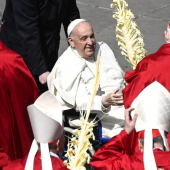Laudato Si’ inspires Holy See’s “Open Work” Pavilion for Venice Biennale 2025

In celebration of the 10th anniversary of Laudato Si’, the Holy See has officially presented its Pavilion for the upcoming 19th International Architecture Exhibition – Venice Biennale 2025, under the theme Opera Aperta or Open Work.
The presentation was made during a press conference held at the Holy See Press Office, on April 9, highlighting the Church’s commitment to fostering dialogue between faith, architecture, ecology, and community engagement.
The Pavilion, organized by the Dicastery for Culture and Education, aims to offer a living testimony to the prophetic call of Laudato Si’, Pope Francis’ landmark encyclical on care for our common home. The exhibition will run from May 10 to November 23, 2025, in Venice, Italy.
Speaking at the event, Cardinal José Tolentino de Mendonça, Prefect of the Dicastery, emphasized the spiritual and cultural importance of Laudato Si’ in shaping a new vision for architecture and human living.
“Laudato Si’ is not only a great religious text but also a cultural and political manifesto. It urges us to become wise curators of relationships—with the environment and among ourselves,” the Cardinal said.
The Holy See’s Pavilion, he added, will be a “pavilion-parable”, unfolding within the old oratory of Santa Maria Ausiliatrice in Venice. As the building undergoes structural repairs, it will simultaneously become a space of healing for community ties, intergenerational hospitality, and urban renewal.
“It is an active laboratory of collective human intelligence—bringing together reason and affection, professionalism and conviviality,” he said.
The 2025 Pavilion is curated by Professor Marina Otero Verzier, who joined remotely, and Dr. Giovanna Zabotti, both known for their interdisciplinary approach to architecture and culture. The project is led by Tatiana Bilbao, a prominent Mexican architect, whose design language embraces social connectivity, sustainable design, and contextual engagement.
Also joining the project are the MAIO Architects collective from Barcelona, represented remotely by Anna Puigjaner, known for advocating open, adaptive architecture that reflects social and environmental relationships.
Further collaboration includes production by Cor Arquitetos, led by architect Roberto Cremascoli, alongside designers Erika Pisciotta and Camilla Dunantoni. The Pavilion will also feature contributions from a diverse group of artists and architects.
Cardinal Tolentino extended special thanks to the project’s main sponsors: Intesa Sanpaolo, represented by Dr. Michele Coppola, and the DST Group, represented remotely by its president José Teixeira, for their continued support in bringing artistic and spiritual projects to life. The initiative also enjoys strong backing from the Municipality of Venice and the Patriarchate of Venice.
Echoing the message of Laudato Si’ paragraph 91—“Everything is connected”—the Pavilion embodies the Church’s call for a holistic approach to environmental, cultural, and human development.
By making space for repair, dialogue, and shared responsibility, the Holy See’s Opera Aperta pavilion seeks to be a sacred and social architecture—where building becomes a sign of healing, and art becomes an invitation to live responsibly in our common home.
Radio Veritas Asia (RVA), a media platform of the Catholic Church, aims to share Christ. RVA started in 1969 as a continental Catholic radio station to serve Asian countries in their respective local language, thus earning the tag “the Voice of Asian Christianity.” Responding to the emerging context, RVA embraced media platforms to connect with the global Asian audience via its 21 language websites and various social media platforms.












